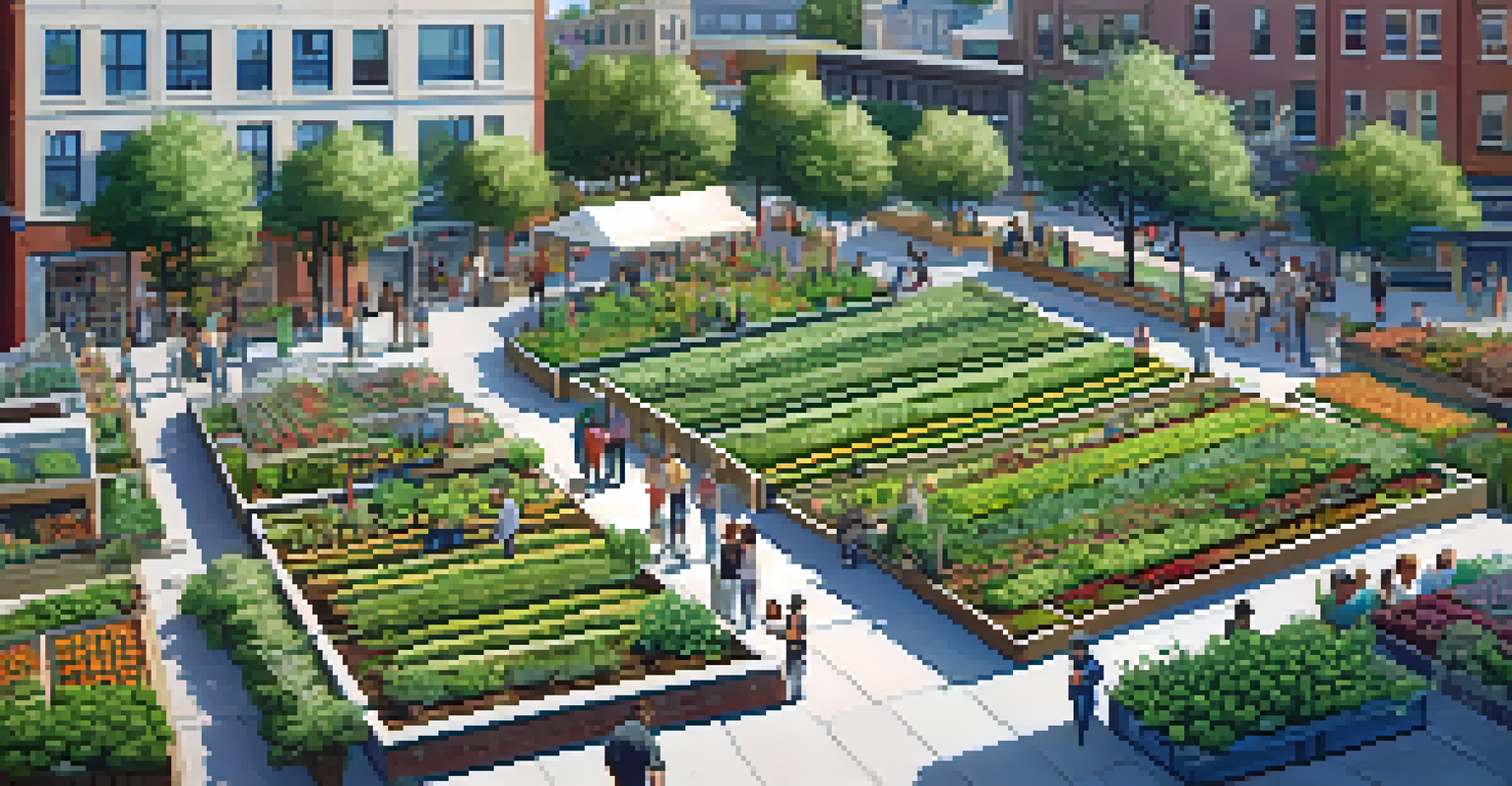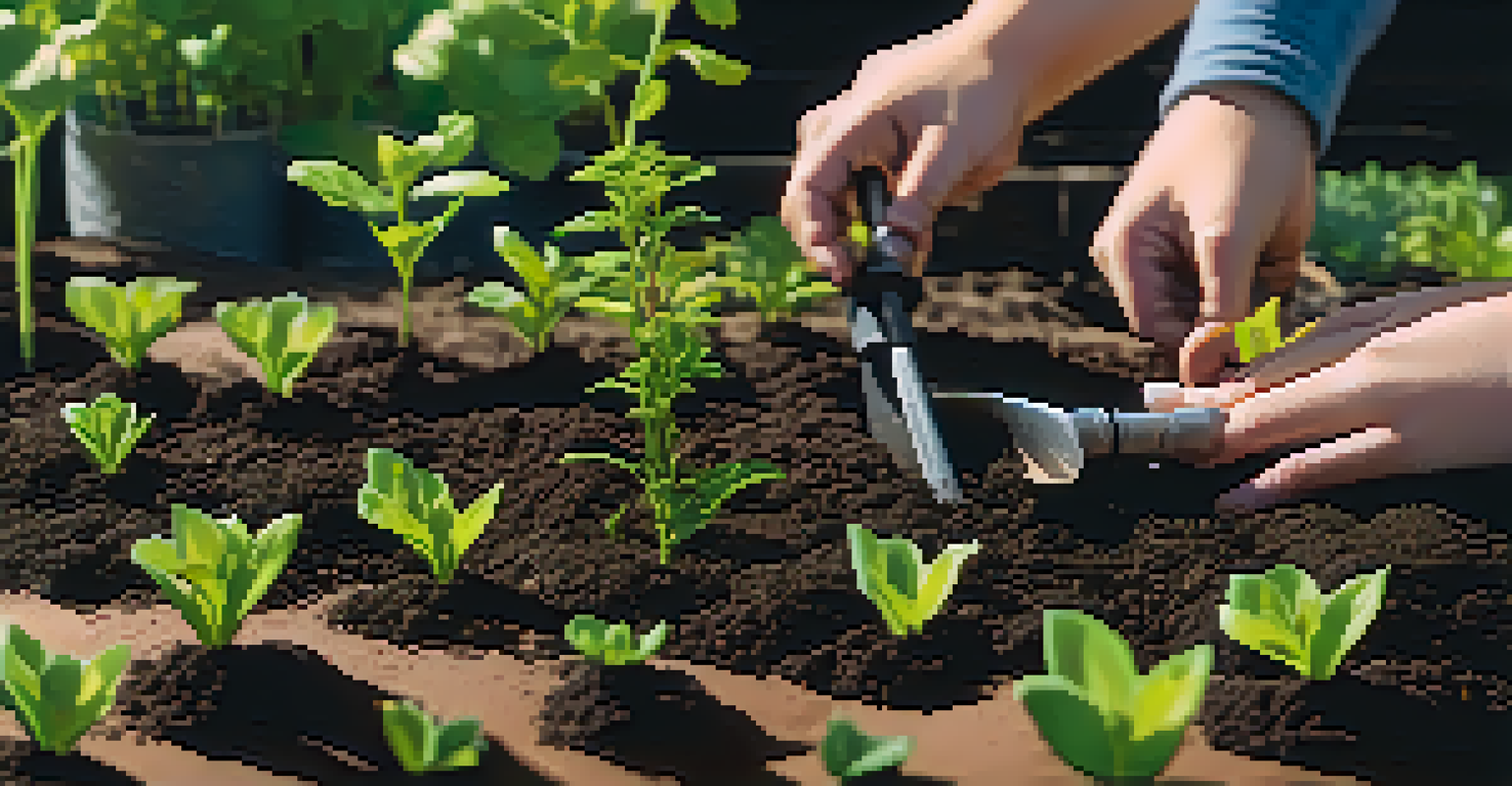The Role of Community Gardens in Enhancing Urban Agriculture

Understanding Community Gardens and Urban Agriculture
Community gardens are shared spaces where individuals can cultivate plants, often in urban settings. These gardens not only provide fresh produce but also create a sense of community among participants. By transforming underutilized land into productive gardens, they play a crucial role in urban agriculture, which focuses on growing food in cities.
The love of gardening is a seed once sown that never dies.
Urban agriculture refers to the practice of cultivating, processing, and distributing food in urban environments. It aims to enhance food security and promote sustainable practices while reducing the carbon footprint associated with transporting food. Community gardens are a vital part of this movement, offering a hands-on solution to local food production.
In essence, community gardens serve as a bridge between urban living and sustainable agriculture. They empower residents to take charge of their food sources, fostering a culture of self-sufficiency and environmental stewardship. This transformation is essential as cities continue to grow and the demand for local food increases.
Benefits of Community Gardens for Local Communities
One of the most significant benefits of community gardens is their ability to foster community engagement. These shared spaces encourage neighbors to work together, fostering relationships and creating a sense of belonging. When people collaborate on projects like planting and harvesting, they often build friendships that extend beyond the garden.

Additionally, community gardens promote health and wellness by providing access to fresh, nutritious produce. In urban areas where grocery stores may be scarce, these gardens become a vital source of fruits and vegetables, contributing to improved diets. Plus, the act of gardening itself can be a form of exercise, promoting physical health and mental well-being.
Community Gardens Foster Connection
These shared spaces encourage collaboration among neighbors, building relationships and a sense of belonging.
Furthermore, community gardens often host educational workshops and events, allowing participants to learn about sustainable practices, nutrition, and horticulture. This education empowers individuals with knowledge and skills that can be applied in their own kitchens and gardens, leading to a more informed and health-conscious community.
Environmental Impact of Community Gardens
Community gardens play a significant role in promoting urban biodiversity. By creating green spaces in cities, they provide habitats for various species, including pollinators like bees and butterflies. This increase in biodiversity is essential for maintaining ecological balance and supporting healthy ecosystems within urban settings.
To plant a garden is to believe in tomorrow.
Moreover, these gardens contribute to improved air quality by absorbing carbon dioxide and releasing oxygen. The plants in community gardens can also help mitigate urban heat, reducing the overall temperature in densely populated areas. This cooling effect is particularly beneficial as cities face the challenges of climate change and increasing heatwaves.
In essence, community gardens are not just about growing food; they are also about fostering a healthier environment. By converting concrete jungles into green spaces, they enhance urban living and make cities more resilient to environmental challenges, showcasing the interconnectedness of nature and urban life.
Community Gardens as Educational Spaces
Community gardens are excellent platforms for education, teaching participants about sustainable practices and the importance of local food systems. Many gardens include workshops on topics like composting, organic gardening, and seasonal planting, empowering individuals with practical skills. These lessons often extend beyond gardening, fostering a deeper appreciation for environmental stewardship.
Involving schools in community gardens can further enhance educational opportunities. Students can learn about biology, ecology, and nutrition firsthand, cultivating a sense of responsibility toward the environment. This hands-on learning approach not only makes education more engaging but also encourages students to connect with their community.
Educational Value of Community Gardens
They serve as platforms for learning, teaching sustainable practices and fostering environmental stewardship.
Ultimately, these educational experiences can inspire the next generation of environmentally-conscious individuals. By instilling a love for gardening and an understanding of sustainable practices, community gardens can contribute to a future where urban agriculture is embraced and celebrated.
Economic Benefits of Community Gardens
Community gardens can significantly impact local economies by providing fresh produce at lower prices than commercial retailers. This affordability is especially important in food deserts, where access to fresh food is limited. By growing their own fruits and vegetables, community members can save money while improving their diets.
Furthermore, these gardens often create job opportunities related to gardening, landscaping, and environmental education. Local residents may find employment in managing the gardens or leading workshops, contributing to the economic growth of their communities. This can be particularly beneficial in areas with high unemployment rates.
Additionally, community gardens can increase property values in surrounding neighborhoods. The presence of green spaces often makes areas more attractive to potential homebuyers and renters. In this way, community gardens contribute not only to food production but also to the overall economic vitality of urban areas.
Challenges Faced by Community Gardens
Despite their many benefits, community gardens often face challenges that can hinder their success. One of the primary issues is securing land access and ownership. Many gardens operate on temporary leases, making it difficult for gardeners to invest time and resources into their plots without knowing if they can continue in the future.
Another challenge is funding. Community gardens typically rely on grants, donations, and volunteer labor, which can be inconsistent. Without adequate financial resources, maintaining and expanding these gardens can become a daunting task, limiting their potential impact on the community.
Economic Impact of Community Gardens
Community gardens provide fresh produce at lower prices, create job opportunities, and can enhance property values.
Weather and environmental factors can also pose significant challenges. Urban gardens are susceptible to issues like soil contamination, pests, and unpredictable weather patterns. Gardeners must be prepared to tackle these obstacles to ensure their gardens thrive, which requires resilience and ingenuity.
How to Get Involved with Community Gardens
Getting involved with a community garden is easier than you might think! Start by researching local gardens in your area, many of which have websites or social media pages detailing their missions and activities. Reach out to them to learn about volunteer opportunities, events, or membership options.
If you feel inspired, consider starting your own community garden. Gather a group of interested neighbors, secure land, and collaborate on a plan for the garden. This process can be incredibly rewarding, as it allows you to cultivate not only plants but also relationships within your community.

Don't forget that community gardens thrive on collaboration and shared resources. Whether you’re lending a hand at a local garden or starting your own, your involvement can contribute to a greener, healthier urban environment, making a positive impact on your community.